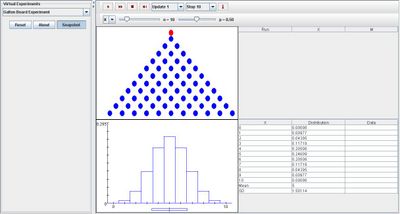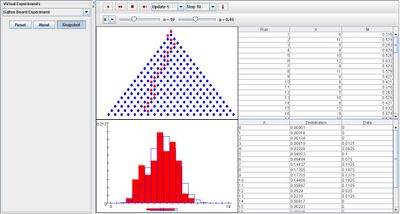SOCR EduMaterials Activities GaltonBoardExperiment
From Socr
Contents |
Galton Board Experiment
Description
The Galton board experiment consists of performing n Bernoulli trials with probability of success p. The trial outcomes are represented graphically as a path in the Galton board: success corresponds to a bounce to the right and failure to a bounce to the left. The number of successes X and the proportion of successes M are recorded on each update. Graphically, X is the number of the peg in the last row of the Galton board that the ball hits. The distribution and moments of the selected variable (X or M) are given in the distribution graph and the distribution table. The parameters n and p can be varied with scroll bars
Goal
To provide a demonstration to give a better understanding of Bernoulli trials as the Galton board.
Experiment
Go to the SOCR Experiment [[1]] and select the Galton Board Experiment from the drop-down list of experiments on the top left. The image below shows the initial view of this experiment:

When pressing the play button, one trial will be executed and recorded in the distribution table below. The fast forward button symbolizes the nth number of trials to be executed each time. The stop button ceases any activity and is helpful when the experimenter chooses “continuous,” indicating an infinite number of events. The fourth button will reset the entire experiment, deleting all previous information and data collected.
The “update” scroll indicates nth number of trials (1, 10, 100, or 1000) performed when selecting the fast forward button and the “stop” scroll indicates the maximum number of trials in the experiment.
When varying p, it only shifts the distribution graph below from left to right. At its extremities, the graph will only hold values for 0 or n. As the number of trials increase, the empirical density and moments graph converges to the distribution graph. The figure below demonstrates this:

Applications
The Galton Board Experiment involves the concepts of Bernoulli trials. It may also be used in place of other activities that occur in daily lives:
Suppose the Galton Board may represent a hill and constructors want to be able to demonstrate the behaviors of water trailing down the hill when it rains. They utilize this applet to show computationally what may occur under these circumstances.
Translate this page:
